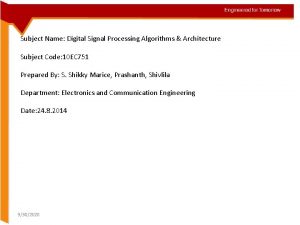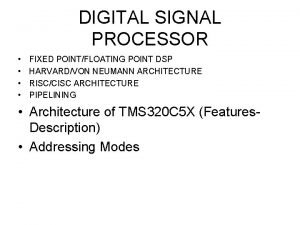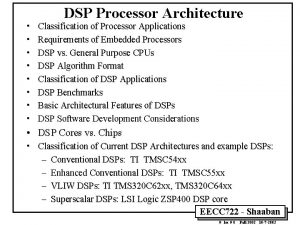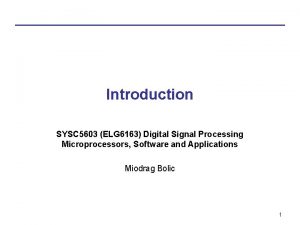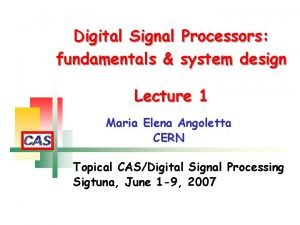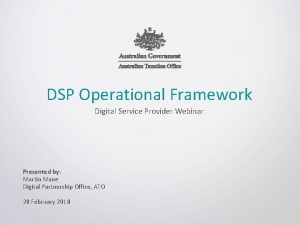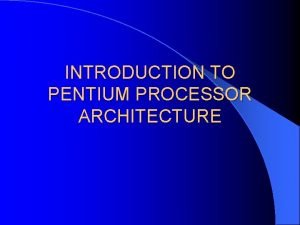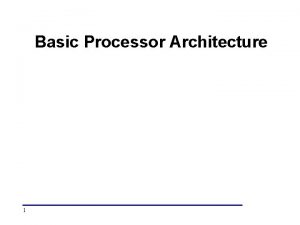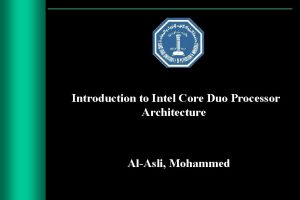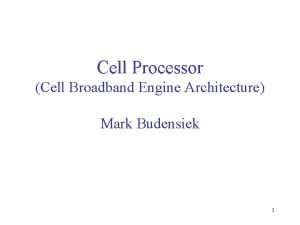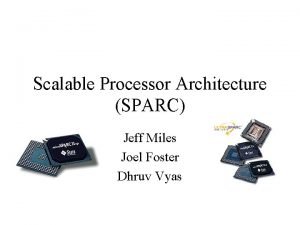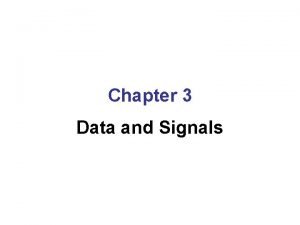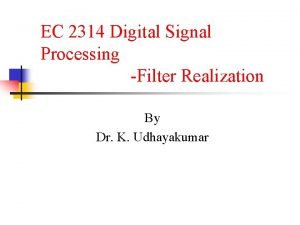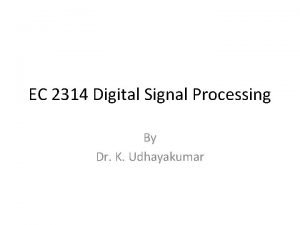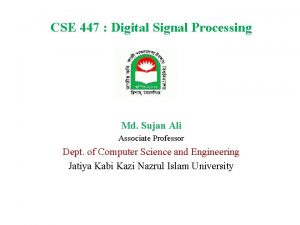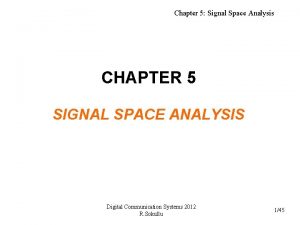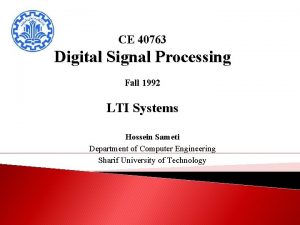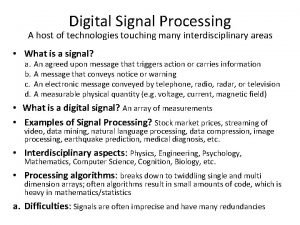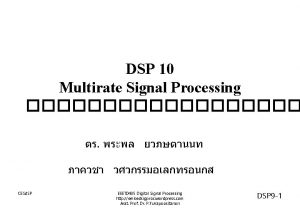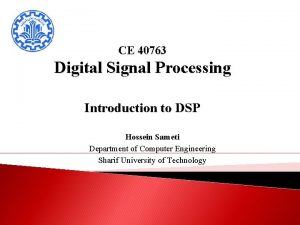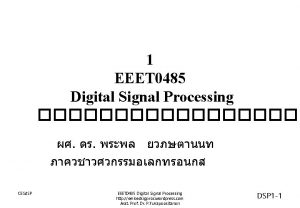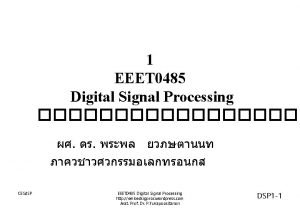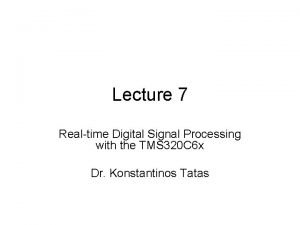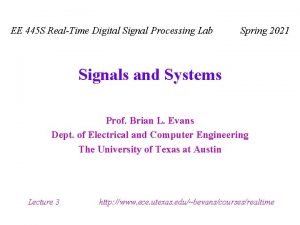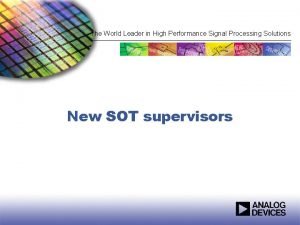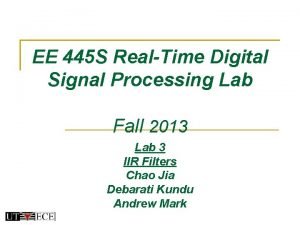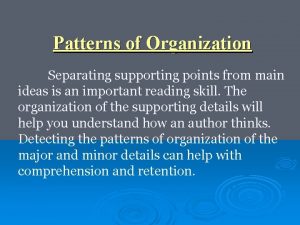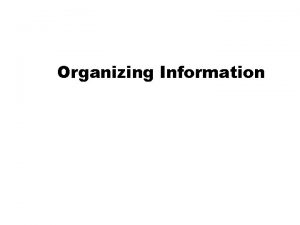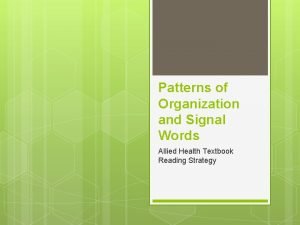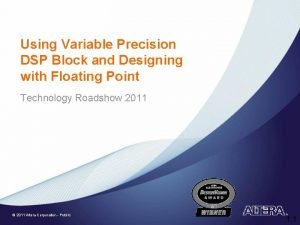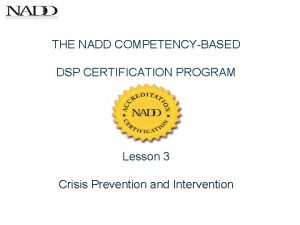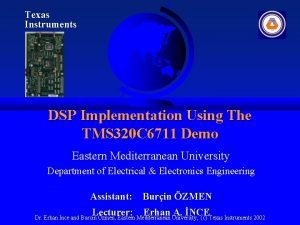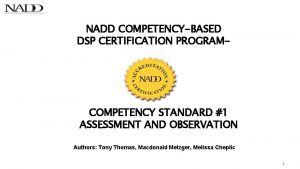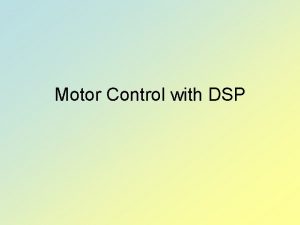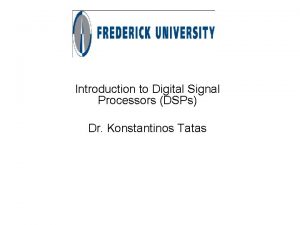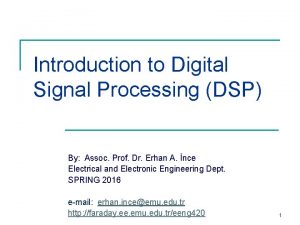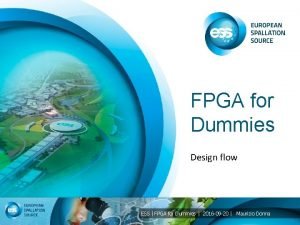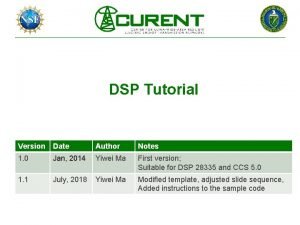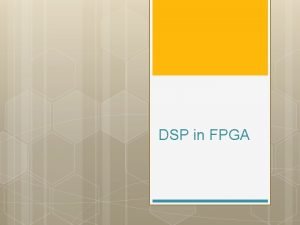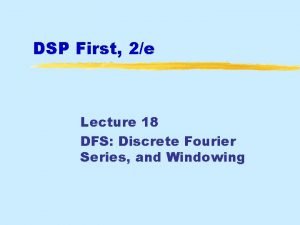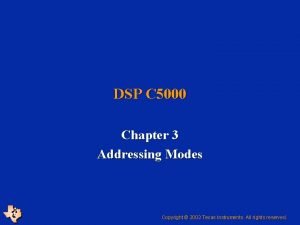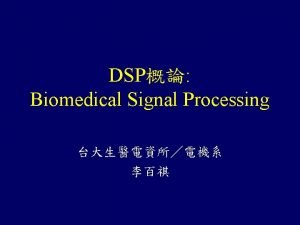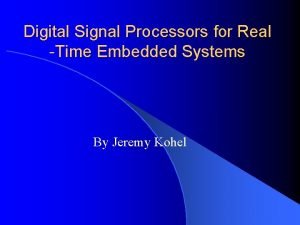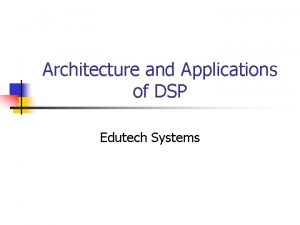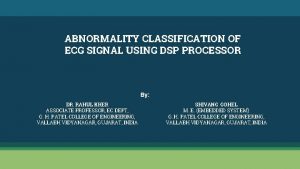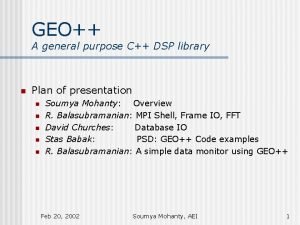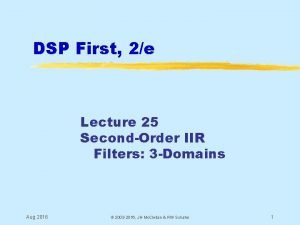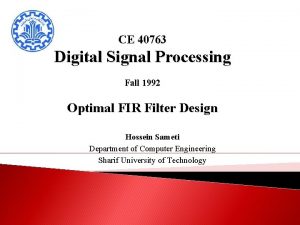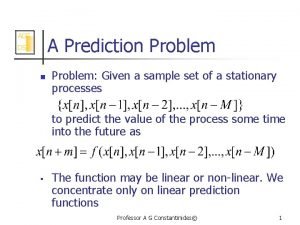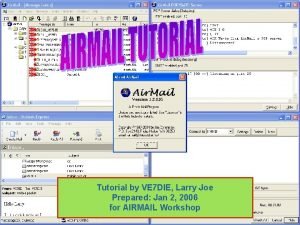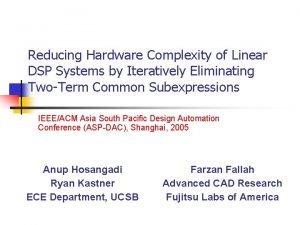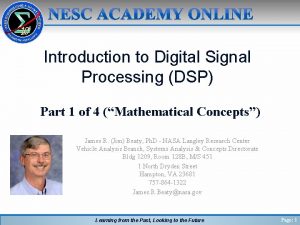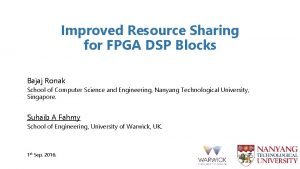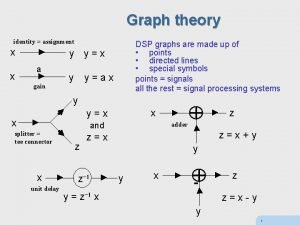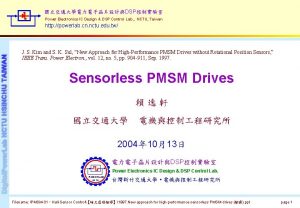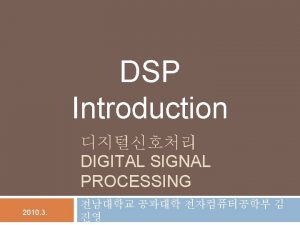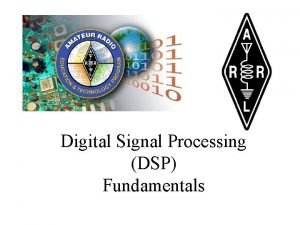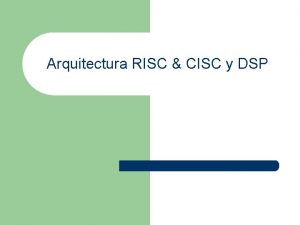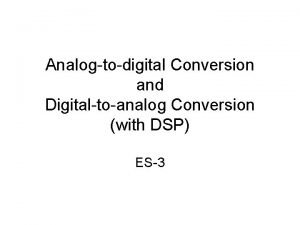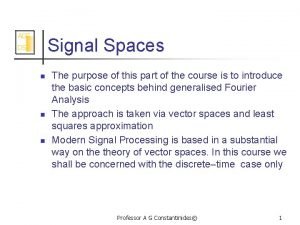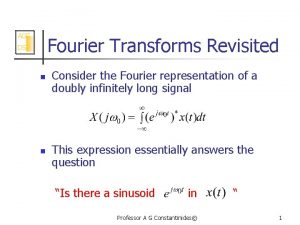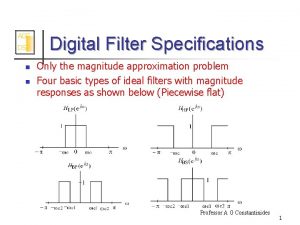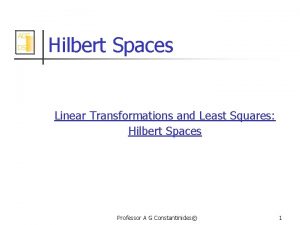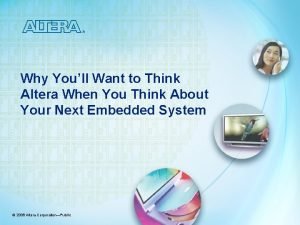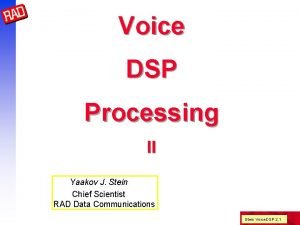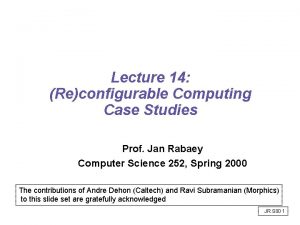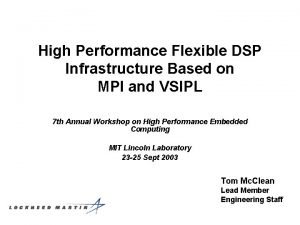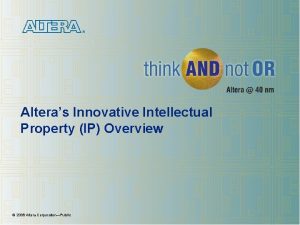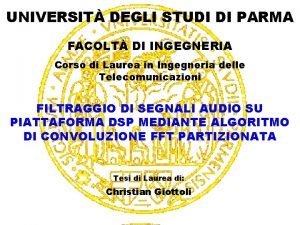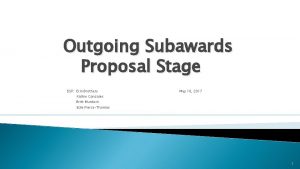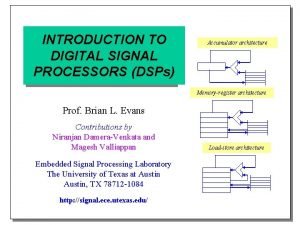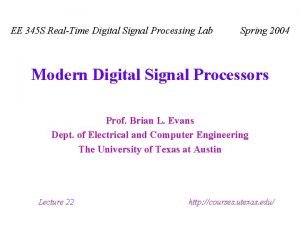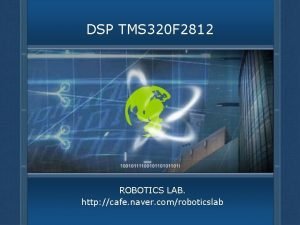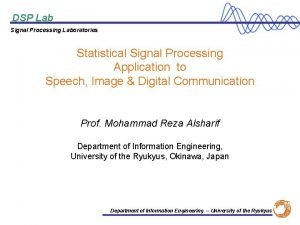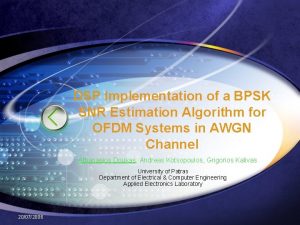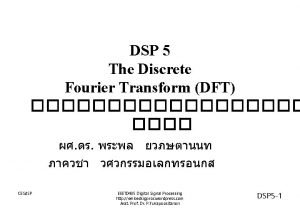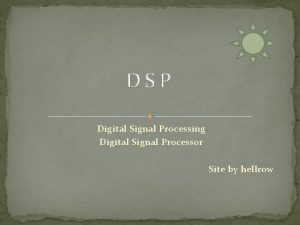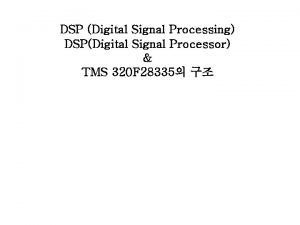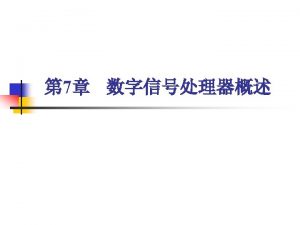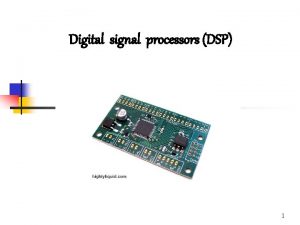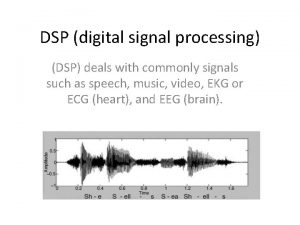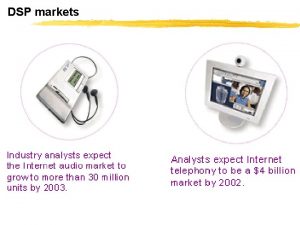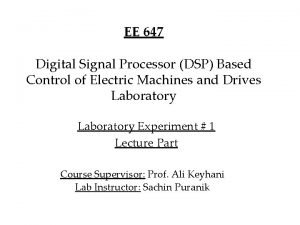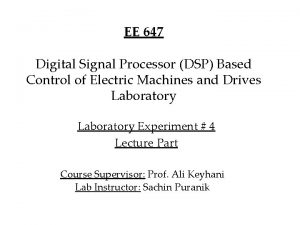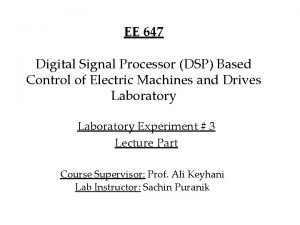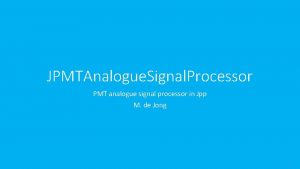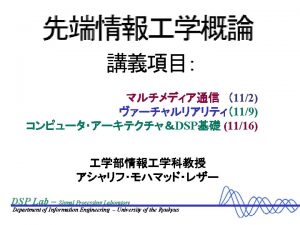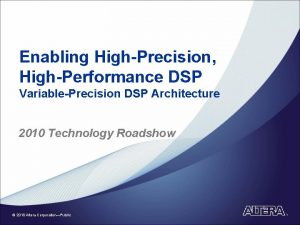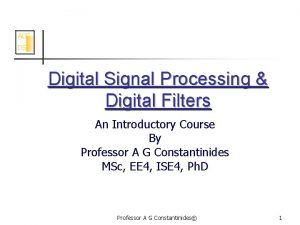Digital Signal Processor DSP Architecture Classification of Processor































































































- Slides: 95

Digital Signal Processor (DSP) Architecture • Classification of Processor Applications • Requirements of Embedded Processors • DSP vs. General Purpose CPUs • DSP Cores vs. Chips • • • Classification of DSP Applications DSP Algorithm Format DSP Benchmarks Basic Architectural Features of DSPs DSP Software Development Considerations Classification of Current DSP Architectures and example DSPs: – Conventional DSPs: TI TMSC 54 xx – Enhanced Conventional DSPs: TI TMSC 55 xx – VLIW DSPs: TI TMS 320 C 62 xx, TMS 320 C 64 xx – Superscalar DSPs: LSI Logic ZSP 400 DSP core EECC 722 - Shaaban # lec # 8 Fall 2003 10 -8 -2003

• • Increasing volume • General Purpose Processors (GPPs) - high performance. – Alpha’s, SPARC, MIPS. . . – Used for general purpose software – Heavy weight OS - UNIX, Windows – Workstations, PC’s, Clusters Embedded processors and processor cores – ARM, 486 SX, Hitachi SH 7000, NEC V 800. . . – Often require Digital signal processing (DSP) support. – Single program – Lightweight, often realtime OS – Cellular phones, consumer electronics. . (e. g. CD players) Microcontrollers – Extremely cost sensitive – Small word size - 8 bit common – Highest volume processors by far – Control systems, Automobiles, toasters, thermostats, . . . Increasing Cost Processor Applications EECC 722 - Shaaban # lec # 8 Fall 2003 10 -8 -2003

$30 B 32 -bit micro $1. 2 B/4% Processor Markets $5. 2 B/17% 32 bit DSP $10 B/33% 16 -bit micro $5. 7 B/19% 8 -bit micro $9. 3 B/31% EECC 722 - Shaaban # lec # 8 Fall 2003 10 -8 -2003

Performance The Processor Design Space Application specific architectures for performance Embedded processors Microprocessors Performance is everything & Software rules Microcontrollers Cost is everything Cost EECC 722 - Shaaban # lec # 8 Fall 2003 10 -8 -2003

Requirements of Embedded Processors • Optimized for a single program - code often in on-chip ROM or off chip EPROM • Minimum code size (one of the motivations initially for Java) • Performance obtained by optimizing datapath • Low cost – Lowest possible area – Technology behind the leading edge – High level of integration of peripherals (reduces system cost) • Fast time to market – Compatible architectures (e. g. ARM) allows reusable code – Customizable cores (System-on-Chip, So. C). • Low power if application requires portability EECC 722 - Shaaban # lec # 8 Fall 2003 10 -8 -2003

Area of processor cores = Cost Nintendo processor Cellular phones EECC 722 - Shaaban # lec # 8 Fall 2003 10 -8 -2003

Another figure of merit: Computation per unit area Nintendo processor Cellular phones EECC 722 - Shaaban # lec # 8 Fall 2003 10 -8 -2003

Code size • If a majority of the chip is the program stored in ROM, then code size is a critical issue • The Piranha has 3 sized instructions - basic 2 byte, and 2 byte plus 16 or 32 bit immediate EECC 722 - Shaaban # lec # 8 Fall 2003 10 -8 -2003

Embedded Systems vs. General Purpose Computing Embedded System • Runs a few applications often known at design time • Not end-user programmable • Operates in fixed run-time constraints that must be met, additional performance may not be useful/valuable • Differentiating features: – Application-specific capability (e. g DSP). – power – cost – speed (must be predictable) General purpose computing • Intended to run a fully general set of applications • End-user programmable • Faster is always better • Differentiating features – speed (need not be fully predictable) – cost (largest component power) EECC 722 - Shaaban # lec # 8 Fall 2003 10 -8 -2003

Evolution of GPPs and DSPs • General Purpose Processors (GPPs) trace roots back to Eckert, Mauchly, Von Neumann (ENIAC) • DSP processors are microprocessors designed for efficient mathematical manipulation of digital signals. – DSP evolved from Analog Signal Processors (ASPs), using analog hardware to transform physical signals (classical electrical engineering) – ASP to DSP because • DSP insensitive to environment (e. g. , same response in snow or desert if it works at all) • DSP performance identical even with variations in components; 2 analog systems behavior varies even if built with same components with 1% variation • Different history and different applications led to different terms, different metrics, some new inventions. EECC 722 - Shaaban # lec # 8 Fall 2003 10 -8 -2003

DSP vs. General Purpose CPUs • DSPs tend to run one program, not many programs. – Hence OSes are much simpler, there is no virtual memory or protection, . . . • DSPs usually run applications with hard real-time constraints: – You must account for anything that could happen in a time slot – All possible interrupts or exceptions must be accounted for and their collective time be subtracted from the time interval. – Therefore, exceptions are BAD. • DSPs usually process infinite continuous data streams. • The design of DSP architectures and ISAs driven by the requirements of DSP algorithms. EECC 722 - Shaaban # lec # 8 Fall 2003 10 -8 -2003

DSP vs. GPP • The “MIPS/MFLOPS” of DSPs is speed of Multiply-Accumulate (MAC). – MAC is common in DSP algorithms that involve computing a vector dot product, such as digital filters, correlation, and Fourier transforms. – DSP are judged by whether they can keep the multipliers busy 100% of the time and by how many MACs are performed in each cycle. • The "SPEC" of DSPs is 4 algorithms: – – Inifinite Impule Response (IIR) filters Finite Impule Response (FIR) filters FFT, and convolvers • In DSPs, target algorithms are important: – Binary compatibility not a mojor issue • High-level Software is not (yet) very important in DSPs. – People still write in assembly language for a product to minimize the die area for ROM in the DSP chip. EECC 722 - Shaaban # lec # 8 Fall 2003 10 -8 -2003

TYPES OF DSP PROCESSORS • 32 -BIT FLOATING POINT (5% of market): – – TI TMS 320 C 3 X, TMS 320 C 67 xx AT&T DSP 32 C ANALOG DEVICES ADSP 21 xxx Hitachi SH-4 • 16 -BIT FIXED POINT (95% of market): – – – – TI TMS 320 C 2 X, TMS 320 C 62 xx Infineon TC 1 xxx (Tri. Core 1) MOTOROLA DSP 568 xx, MSC 810 x ANALOG DEVICES ADSP 21 xx Agere Systems DSP 16 xxx, Starpro 2000 LSI Logic LSI 140 x (ZPS 400) Hitachi SH 3 -DSP – Star. Core SC 110, SC 140 EECC 722 - Shaaban # lec # 8 Fall 2003 10 -8 -2003

DSP Cores vs. Chips DSP are usually available as synthesizable cores or off-theshelf chips • Synthesizable Cores: – Map into chosen fabrication process • Speed, power, and size vary – Choice of peripherals, etc. (So. C) – Requires extensive hardware development effort. • Off-the-shelf chips: – Highly optimized for speed, energy efficiency, and/or cost. – Limited performance, integration options. – Tools, 3 rd-party support often more mature EECC 722 - Shaaban # lec # 8 Fall 2003 10 -8 -2003

DSP ARCHITECTURE Enabling Technologies EECC 722 - Shaaban # lec # 8 Fall 2003 10 -8 -2003

Texas Instruments TMS 320 Family Multiple DSP P Generations EECC 722 - Shaaban # lec # 8 Fall 2003 10 -8 -2003

DSP Applications • • • Digital audio applications – MPEG Audio – Portable audio Digital cameras Cellular telephones Wearable medical appliances Storage products: – disk drive servo control Military applications: – radar – sonar • Industrial control • Seismic exploration • Networking: – Wireless – Base station – Cable modems – ADSL – VDSL EECC 722 - Shaaban # lec # 8 Fall 2003 10 -8 -2003

DSP Applications EECC 722 - Shaaban # lec # 8 Fall 2003 10 -8 -2003

• • Increasing volume • High-end – Military applications – Wireless Base Station - TMS 320 C 6000 – Cable modem – gateways Mid-end – Industrial control – Cellular phone - TMS 320 C 540 – Fax/ voice server Low end – Storage products - TMS 320 C 27 – Digital camera - TMS 320 C 5000 – Portable phones – Wireless headsets – Consumer audio – Automobiles, toasters, thermostats, . . . Increasing Cost Another Look at DSP Applications EECC 722 - Shaaban # lec # 8 Fall 2003 10 -8 -2003

DSP range of applications EECC 722 - Shaaban # lec # 8 Fall 2003 10 -8 -2003

CELLULAR TELEPHONE SYSTEM 123 456 789 0 PHYSICAL LAYER PROCESSING A/D 415 -555 -1212 CONTROLLER SPEECH ENCODE BASEBAND CONVERTER SPEECH DECODE RF MODEM DAC EECC 722 - Shaaban # lec # 8 Fall 2003 10 -8 -2003

HW/SW/IC PARTITIONING MICROCONTROLLER 123 456 789 0 ASIC A/D 415 -555 -1212 CONTROLLER PHYSICAL LAYER PROCESSING SPEECH ENCODE BASEBAND CONVERTER SPEECH DECODE RF MODEM DAC DSP ANALOG IC EECC 722 - Shaaban # lec # 8 Fall 2003 10 -8 -2003

Mapping Onto System-on-Chip (So. C) S/P RAM DMA µC S/P phone keypad book intfc DMA control protocol speech quality ASIC LOGIC DSP CORE enhancment voice recognition de-intl & RPE-LTP decoder speech decoder demodulator and synchronizer Viterbi equalizer EECC 722 - Shaaban # lec # 8 Fall 2003 10 -8 -2003

Example Wireless Phone Organization C 540 ARM 7 EECC 722 - Shaaban # lec # 8 Fall 2003 10 -8 -2003

Multimedia I/O Architecture Radio Modem Embedded Processor Sched ECC Pact Interface Low Power Bus FB Data Flow Fifo Video Decomp Pen SRAM Graphics Audio Video EECC 722 - Shaaban # lec # 8 Fall 2003 10 -8 -2003

Multimedia System-on-Chip (So. C) E. g. Multimedia terminal electronics Graphics Out Uplink Radio Downlink Radio Video I/O Voice I/O Pen In µP Video Unit Memory Coms • Future chips will be a mix of processors, memory and dedicated hardware for specific algorithms and I/O custom DSP EECC 722 - Shaaban # lec # 8 Fall 2003 10 -8 -2003

DSP Algorithm Format • DSP culture has a graphical format to represent formulas. • Like a flowchart formulas, inner loops, not programs. • Some seem natural: is add, X is multiply • Others are obtuse: z– 1 means take variable from earlier iteration. • These graphs are trivial to decode EECC 722 - Shaaban # lec # 8 Fall 2003 10 -8 -2003

DSP Algorithm Notation • Uses “flowchart” notation instead of equations • Multiply is or X • Add is + or • Delay/Storage is or or Delay z– 1 D EECC 722 - Shaaban # lec # 8 Fall 2003 10 -8 -2003

Typical DSP Algorithm: Finite-Impulse Response (FIR) Filter • Filters reduce signal noise and enhance image or signal quality by removing unwanted frequencies. • Finite Impulse Response (FIR) filters compute: where – – x is the input sequence y is the output sequence h is the impulse response (filter coefficients) N is the number of taps (coefficients) in the filter • Output sequence depends only on input sequence and impulse response. EECC 722 - Shaaban # lec # 8 Fall 2003 10 -8 -2003

Typical DSP Algorithm: Finite-impulse Response (FIR) Filter • • N most recent samples in the delay line (Xi) New sample moves data down delay line “Tap” is a multiply-add Each tap (N taps total) nominally requires: – – Two data fetches Multiply Accumulate Memory write-back to update delay line • Goal: at least 1 FIR Tap / DSP instruction cycle EECC 722 - Shaaban # lec # 8 Fall 2003 10 -8 -2003

FINITE-IMPULSE RESPONSE (FIR) FILTER X h 0 . . h 1 h. N-2 h. N-1 Y A Tap Goal: at least 1 FIR Tap / DSP instruction cycle EECC 722 - Shaaban # lec # 8 Fall 2003 10 -8 -2003

Sample Computational Rates for FIR Filtering 1 -D FIR has nop = 2 N and a 2 -D FIR has nop = 2 N 2. EECC 722 - Shaaban # lec # 8 Fall 2003 10 -8 -2003

FIR filter on (simple) General Purpose Processor loop: lw x 0, 0(r 0) lw y 0, 0(r 1) mul a, x 0, y 0 add y 0, a, b sw y 0, (r 2) inc r 0 inc r 1 inc r 2 dec ctr tst ctr jnz loop • Problems: Bus / memory bandwidth bottleneck, control code overhead EECC 722 - Shaaban # lec # 8 Fall 2003 10 -8 -2003

Typical DSP Algorithm: Infinite-Impulse Response (IIR) Filter • Infinite Impulse Response (IIR) filters compute: • Output sequence depends on input sequence, previous outputs, and impulse response. • Both FIR and IIR filters – Require dot product (multiply-accumulate) operations – Use fixed coefficients • Adaptive filters update their coefficients to minimize the distance between the filter output and the desired signal. EECC 722 - Shaaban # lec # 8 Fall 2003 10 -8 -2003

Typical DSP Algorithm: Discrete Fourier Transform • The Discrete Fourier Transform (DFT) allows for spectral analysis in the frequency domain. • It is computed as for k = 0, 1, … , N-1, where – x is the input sequence in the time domain – y is an output sequence in the frequency domain • The Inverse Discrete Fourier Transform is computed as • The Fast Fourier Transform (FFT) provides an efficient method for computing the DFT. EECC 722 - Shaaban # lec # 8 Fall 2003 10 -8 -2003

Typical DSP Algorithm: Discrete Cosine Transform (DCT) • The Discrete Cosine Transform (DCT) is frequently used in video compression (e. g. , MPEG-2). • The DCT and Inverse DCT (IDCT) are computed as: where e(k) = 1/sqrt(2) if k = 0; otherwise e(k) = 1. • A N-Point, 1 D-DCT requires N 2 MAC operations. EECC 722 - Shaaban # lec # 8 Fall 2003 10 -8 -2003

DSP BENCHMARKS • DSPstone: University of Aachen, application benchmarks – – ADPCM TRANSCODER - CCITT G. 721, REAL_UPDATE, COMPLEX_UPDATES DOT_PRODUCT, MATRIX_1 X 3, CONVOLUTION FIR, FIR 2 DIM, HR_ONE_BIQUAD LMS, FFT_INPUT_SCALED • BDTImark 2000: Berkeley Design Technology Inc – 12 DSP kernels in hand-optimized assembly language – Returns single number (higher means faster) per processor – Use only on-chip memory (memory bandwidth is the major bottleneck in performance of embedded applications). • EEMBC (pronounced “embassy”): EDN Embedded Microprocessor Benchmark Consortium – 30 companies formed by Electronic Data News (EDN) – Benchmark evaluates compiled C code on a variety of embedded processors (microcontrollers, DSPs, etc. ) – Application domains: automotive-industrial, consumer, office automation, networking and telecommunications EECC 722 - Shaaban # lec # 8 Fall 2003 10 -8 -2003

EECC 722 - Shaaban # lec # 8 Fall 2003 10 -8 -2003

Basic Architectural Features of DSPs • • • Data path configured for DSP – Fixed-point arithmetic – MAC- Multiply-accumulate Multiple memory banks and buses – Harvard Architecture – Multiple data memories Specialized addressing modes – Bit-reversed addressing – Circular buffers Specialized instruction set and execution control – Zero-overhead loops – Support for fast MAC – Fast Interrupt Handling Specialized peripherals for DSP EECC 722 - Shaaban # lec # 8 Fall 2003 10 -8 -2003

DSP Data Path: Arithmetic • DSPs dealing with numbers representing real world => Want “reals”/ fractions • DSPs dealing with numbers for addresses => Want integers • Support “fixed point” as well as integers . -1 Š x < 1 S radix point S . radix – 2 N– 1 Š x < 2 N– 1 point EECC 722 - Shaaban # lec # 8 Fall 2003 10 -8 -2003

DSP Data Path: Precision • Word size affects precision of fixed point numbers • DSPs have 16 -bit, 20 -bit, or 24 -bit data words • Floating Point DSPs cost 2 X - 4 X vs. fixed point, slower than fixed point • DSP programmers will scale values inside code – SW Libraries – Separate explicit exponent • “Blocked Floating Point” single exponent for a group of fractions • Floating point support simplify development EECC 722 - Shaaban # lec # 8 Fall 2003 10 -8 -2003

DSP Data Path: Overflow • DSP are descended from analog : – Modulo Arithmetic. • Set to most positive (2 N– 1– 1) or most negative value(– 2 N– 1) : “saturation” • Many DSP algorithms were developed in this model. EECC 722 - Shaaban # lec # 8 Fall 2003 10 -8 -2003

DSP Data Path: Multiplier • Specialized hardware performs all key arithmetic operations in 1 cycle • 50% of instructions can involve multiplier => single cycle latency multiplier • Need to perform multiply-accumulate (MAC) • n-bit multiplier => 2 n-bit product EECC 722 - Shaaban # lec # 8 Fall 2003 10 -8 -2003

DSP Data Path: Accumulator • Don’t want overflow or have to scale accumulator • Option 1: accumalator wider than product: “guard bits” – Motorola DSP: 24 b x 24 b => 48 b product, 56 b Accumulator • Option 2: shift right and round product before adder Multiplier Shift ALU Accumulator G ALU Accumulator EECC 722 - Shaaban # lec # 8 Fall 2003 10 -8 -2003

DSP Data Path: Rounding • Even with guard bits, will need to round when store accumulator into memory • 3 DSP standard options • Truncation: chop results => biases results up • Round to nearest: < 1/2 round down, � 1/2 round up (more positive) => smaller bias • Convergent: < 1/2 round down, > 1/2 round up (more positive), = 1/2 round to make lsb a zero (+1 if 1, +0 if 0) => no bias IEEE 754 calls this round to nearest even EECC 722 - Shaaban # lec # 8 Fall 2003 10 -8 -2003

Data Path Comparison DSP Processor • Specialized hardware performs all key arithmetic operations in 1 cycle. • Hardware support for managing numeric fidelity: – Shifters – Guard bits – Saturation General-Purpose Processor • Multiplies often take>1 cycle • Shifts often take >1 cycle • Other operations (e. g. , saturation, rounding) typically take multiple cycles. EECC 722 - Shaaban # lec # 8 Fall 2003 10 -8 -2003

TI 320 C 54 x DSP (1995) Functional Block Diagram EECC 722 - Shaaban # lec # 8 Fall 2003 10 -8 -2003

First Commercial DSP (1982): Texas Instruments TMS 32010 • 16 -bit fixed-point arithmetic • Introduced at 5 Mhz (200 ns) instruction cycle. • “Harvard architecture” – separate instruction, data memories Instruction Memory Processor Data Memory Datapath: Mem T-Register • Accumulator • Specialized instruction set – Load and Accumulate • Two-cycle (400 ns) Multiply. Accumulate (MAC) time. Multiplier ALU P-Register Accumulator EECC 722 - Shaaban # lec # 8 Fall 2003 10 -8 -2003

First Generation DSP P Texas Instruments TMS 32010 - 1982 Features • • • 200 ns instruction cycle (5 MIPS) 144 words (16 bit) on-chip data RAM 1. 5 K words (16 bit) on-chip program ROM - TMS 32010 External program memory expansion to a total of 4 K words at full speed 16 -bit instruction/data word single cycle 32 -bit ALU/accumulator Single cycle 16 x 16 -bit multiply in 200 ns Two cycle MAC (5 MOPS) Zero to 15 -bit barrel shifter Eight input and eight output channels EECC 722 - Shaaban # lec # 8 Fall 2003 10 -8 -2003

TMS 32010 BLOCK DIAGRAM EECC 722 - Shaaban # lec # 8 Fall 2003 10 -8 -2003

TMS 32010 FIR Filter Code • Here X 4, H 4, . . . are direct (absolute) memory addresses: LT X 4 ; Load T with x(n-4) MPY H 4 ; P = H 4*X 4 LTD X 3 ; Load T with x(n-3); x(n-4) = x(n 3); ; Acc = Acc + P MPY H 3 ; P = H 3*X 3 LTD X 2 MPY H 2. . . • Two instructions per tap, but requires unrolling EECC 722 - Shaaban # lec # 8 Fall 2003 10 -8 -2003

Micro-architectural impact - MAC element of finite-impulse response filter computation X Y MPY ADD/SUB ACC REG EECC 722 - Shaaban # lec # 8 Fall 2003 10 -8 -2003

Mapping of the filter onto a DSP execution unit 1 Xn X 2 3 b a. Y 5 S X n-1 4 6 Yn 4 6 1 2 D a 5 D 3 • The critical hardware unit in a DSP is the multiplier - much of the architecture is organized around allowing use of the multiplier on every cycle • This means providing two operands on every cycle, through multiple data and address busses, multiple address units and local accumulator feedback EECC 722 - Shaaban # lec # 8 Fall 2003 10 -8 -2003

MAC Eg. - 320 C 54 x DSP Functional Block Diagram EECC 722 - Shaaban # lec # 8 Fall 2003 10 -8 -2003

DSP Memory • FIR Tap implies multiple memory accesses • DSPs require multiple data ports • Some DSPs have ad hoc techniques to reduce memory bandwdith demand: – Instruction repeat buffer: do 1 instruction 256 times – Often disables interrupts, thereby increasing interrupt response time • Some recent DSPs have instruction caches – Even then may allow programmer to “lock in” instructions into cache – Option to turn cache into fast program memory • No DSPs have data caches. • May have multiple data memories EECC 722 - Shaaban # lec # 8 Fall 2003 10 -8 -2003

Conventional ``Von Neumann’’ memory EECC 722 - Shaaban # lec # 8 Fall 2003 10 -8 -2003

HARVARD MEMORY ARCHITECTURE in DSP PROGRAM MEMORY X MEMORY Y MEMORY GLOBAL P DATA X DATA Y DATA EECC 722 - Shaaban # lec # 8 Fall 2003 10 -8 -2003

Memory Architecture Comparison • • • DSP Processor Harvard architecture 2 -4 memory accesses/cycle No caches-on-chip SRAM • • • General-Purpose Processor Von Neumann architecture Typically 1 access/cycle Use caches Program Memory Processor Memory Data Memory EECC 722 - Shaaban # lec # 8 Fall 2003 10 -8 -2003

Eg. TMS 320 C 3 x MEMORY BLOCK DIAGRAM - Harvard Architecture EECC 722 - Shaaban # lec # 8 Fall 2003 10 -8 -2003

Eg. TI 320 C 62 x/67 x DSP (1997) EECC 722 - Shaaban # lec # 8 Fall 2003 10 -8 -2003

DSP Addressing • Have standard addressing modes: immediate, displacement, register indirect • Want to keep MAC datapath busy • Assumption: any extra instructions imply clock cycles of overhead in inner loop => complex addressing is good => don’t use datapath to calculate fancy address • Autoincrement/Autodecrement register indirect – lw r 1, 0(r 2)+ => r 1 <- M[r 2]; r 2<-r 2+1 – Option to do it before addressing, positive or negative EECC 722 - Shaaban # lec # 8 Fall 2003 10 -8 -2003

DSP Addressing: FFT • FFTs start or end with data in bufferfly order 0 (000) => 0 (000) 1 (001) => 4 (100) 2 (010) => 2 (010) 3 (011) => 6 (110) 4 (100) => 1 (001) 5 (101) => 5 (101) 6 (110) => 3 (011) 7 (111) => 7 (111) • What can do to avoid overhead of address checking instructions for FFT? • Have an optional “bit reverse” addressing mode for use with autoincrement addressing • Many DSPs have “bit reverse” addressing for radix-2 FFT EECC 722 - Shaaban # lec # 8 Fall 2003 10 -8 -2003

BIT REVERSED ADDRESSING Data flow in the radix-2 decimation-in-time FFT algorithm EECC 722 - Shaaban # lec # 8 Fall 2003 10 -8 -2003

DSP Addressing: Buffers • DSPs dealing with continuous I/O • Often interact with an I/O buffer (delay lines) • To save memory, buffers often organized as circular buffers • What can do to avoid overhead of address checking instructions for circular buffer? • Option 1: Keep start register and end register per address register for use with autoincrement addressing, reset to start when reach end of buffer • Option 2: Keep a buffer length register, assuming buffers starts on aligned address, reset to start when reach end • Every DSP has “modulo” or “circular” addressing EECC 722 - Shaaban # lec # 8 Fall 2003 10 -8 -2003

CIRCULAR BUFFERS Instructions accomodate three elements: • buffer address • buffer size • increment Allows for cycling through: • delay elements • coefficients in data memory EECC 722 - Shaaban # lec # 8 Fall 2003 10 -8 -2003

Addressing Comparison DSP Processor • Dedicated address generation units • Specialized addressing modes; e. g. : – Autoincrement – Modulo (circular) – Bit-reversed (for FFT) • Good immediate data support General-Purpose Processor • Often, no separate address generation unit • General-purpose addressing modes EECC 722 - Shaaban # lec # 8 Fall 2003 10 -8 -2003

Address calculation unit for DSPs • Supports modulo and bit reversal arithmetic • Often duplicated to calculate multiple addresses per cycle EECC 722 - Shaaban # lec # 8 Fall 2003 10 -8 -2003

DSP Instructions and Execution • • May specify multiple operations in a single instruction Must support Multiply-Accumulate (MAC) Need parallel move support Usually have special loop support to reduce branch overhead – Loop an instruction or sequence – 0 value in register usually means loop maximum number of times – Must be sure if calculate loop count that 0 does not mean 0 • May have saturating shift left arithmetic • May have conditional execution to reduce branches EECC 722 - Shaaban # lec # 8 Fall 2003 10 -8 -2003

ADSP 2100: ZERO-OVERHEAD LOOP DO <addr> UNTIL condition” DO X. . . X Address Generation PCS = PC + 1 if (PC = x && ! condition) PC = PCS else PC = PC +1 • Eliminates a few instructions in loops • Important in loops with small bodies EECC 722 - Shaaban # lec # 8 Fall 2003 10 -8 -2003

Instruction Set Comparison DSP Processor General-Purpose Processor • Specialized, complex instructions • Multiple operations per instruction mac x 0, y 0, a x: (r 0) + , x 0 y: (r 4) + , y 0 • General-purpose instructions • Typically one operation per instruction mov *r 0, x 0 mov *r 1, y 0 mpy x 0, y 0, a add a, b mov y 0, *r 2 inc r 0 inc rl EECC 722 - Shaaban # lec # 8 Fall 2003 10 -8 -2003

Specialized Peripherals for DSPs DSP Core A/D Converter D/A Converter Instruction Memory Data Memory Serial Ports • Synchronous serial ports • Parallel ports • Timers • On-chip A/D, D/A converters • Host ports • Bit I/O ports • On-chip DMA controller • Clock generators • On-chip peripherals often designed for “background” operation, even when core is powered down. EECC 722 - Shaaban # lec # 8 Fall 2003 10 -8 -2003

Specialized DSP peripherals EECC 722 - Shaaban # lec # 8 Fall 2003 10 -8 -2003

TI TMS 320 C 203/LC 203 BLOCK DIAGRAM DSP Core Approach - 1995 EECC 722 - Shaaban # lec # 8 Fall 2003 10 -8 -2003

Summary of Architectural Features of DSPs • • • Data path configured for DSP – Fixed-point arithmetic – MAC- Multiply-accumulate Multiple memory banks and buses – Harvard Architecture – Multiple data memories Specialized addressing modes – Bit-reversed addressing – Circular buffers Specialized instruction set and execution control – Zero-overhead loops – Support for MAC Specialized peripherals for DSP THE ULTIMATE IN BENCHMARK DRIVEN ARCHITECTURE DESIGN. EECC 722 - Shaaban # lec # 8 Fall 2003 10 -8 -2003

DSP Software Development Considerations • Different from general-purpose software development: – – – Resource-hungry, complex algorithms. Specialized and/or complex processor architectures. Severe cost/storage limitations. Hard real-time constraints. Optimization is essential. Increased testing challenges. • Essential tools: • – Assembler, linker. – Instruction set simulator. – HLL Code generation: C compiler. – Debugging and profiling tools. Increasingly important: – Software libraries. – Real-time operating systems. EECC 722 - Shaaban # lec # 8 Fall 2003 10 -8 -2003

Classification of Current DSP Architectures • Modern Conventional DSPs: – Similar to the original DSPs of the early 1980 s – Single instruction/cycle. Example: TI TMS 320 C 54 x • Enhanced Conventional DSPs: – Add parallel execution units: SIMD operation – Complex, compound instructions. Example: TI TMS 320 C 55 x • Multiple-Issue DSPs: – VLIW Example: TI TMS 320 C 62 xx, TMS 320 C 64 xx – Superscalar, Example: LSI Logic ZPS 400 EECC 722 - Shaaban # lec # 8 Fall 2003 10 -8 -2003

A Conventional DSP: TI TMSC 54 xx • • 16 -bit fixed-point DSP. Issues one 16 -bit instruction/cycle Modified Harvard memory architecture Peripherals typical of conventional DSPs: – 2 -3 synch. Serial ports, parallel port – Bit I/O, Timer, DMA • Inexpensive (100 MHz ~$5 qty 10 K). • Low power (60 m. W @ 1. 8 V, 100 MHz). EECC 722 - Shaaban # lec # 8 Fall 2003 10 -8 -2003

A Current Conventional DSP: TI TMSC 54 xx EECC 722 - Shaaban # lec # 8 Fall 2003 10 -8 -2003

An Enhanced Conventional DSP: TI TMSC 55 xx • The TMS 320 C 55 xx is based on Texas Instruments' earlier TMS 320 C 54 xx family, but adds significant enhancements to the architecture and instruction set, including: – Two instructions/cycle • Instructions are scheduled for parallel execution by the assembly programmer or compiler. – Two MAC units. • Complex, compound instructions: – Assembly source code compatible with C 54 xx – Mixed-width instructions: 8 to 48 bits. – 200 MHz @ 1. 5 V, ~130 m. W , $17 qty 10 k • Poor compiler target. EECC 722 - Shaaban # lec # 8 Fall 2003 10 -8 -2003

An Enhanced Conventional DSP: TI TMSC 55 xx EECC 722 - Shaaban # lec # 8 Fall 2003 10 -8 -2003

16 -bit Fixed-Point VLIW DSP: TI TMS 320 C 6201 Revision 2 (1997) The TMS 320 C 62 xx is the Program Cache / Program Memory 32 -bit address, 256 -Bit data 512 K Bits RAM first fixed-point DSP processor from Texas Instruments that is based on a VLIW-like architecture which allows it to execute up Pwr Dwn Program Fetch Control Registers Instruction Dispatch Host Port Interface 4 -DMA to eight 32 -bit RISC-like instructions per clock cycle. C 6201 CPU Megamodule Instruction Decode Data Path 1 Data Path 2 A Register File Control Logic B Register File Test Emulation Ext. Memory Interface L 1 S 1 M 1 D 2 M 2 S 2 L 2 Interrupts 2 Timers Data Memory 32 -Bit address, 8 -, 16 -, 32 -Bit data 512 K Bits RAM 2 Multichannel buffered serial ports (T 1/E 1) EECC 722 - Shaaban # lec # 8 Fall 2003 10 -8 -2003

C 6201 Internal Memory Architecture • • • Separate Internal Program and Data Spaces Program – 16 K 32 -bit instructions (2 K Fetch Packets) – 256 -bit Fetch Width – Configurable as either • Direct Mapped Cache, Memory Mapped Program Memory Data – 32 K x 16 – Single Ported Accessible by Both CPU Data Buses – 4 x 8 K 16 -bit Banks • 2 Possible Simultaneous Memory Accesses (4 Banks) • 4 -Way Interleave, Banks and Interleave Minimize Access Conflicts EECC 722 - Shaaban # lec # 8 Fall 2003 10 -8 -2003

C 62 x Datapaths Registers A 0 - A 15 Registers B 0 - B 15 1 X S 1 2 X S 2 D DL SL L 1 SL D D S L 1 S 2 S D 1 S 2 M 1 DDATA_I 1 (load data) DDATA_O 1 (store data) D S S 1 2 D 1 S S D 2 1 D 2 S 1 D M 2 S D D SL 1 L SL DL D S 2 S 1 L 2 DDATA_I 2 (load data) DDATA_O 2 (store data) DADR 1 DADR 2 (address) Cross Paths 40 -bit Write Paths (8 MSBs) 40 -bit Read Paths/Store Paths EECC 722 - Shaaban # lec # 8 Fall 2003 10 -8 -2003

C 62 x Functional Units • L-Unit (L 1, L 2) – 40 -bit Integer ALU, Comparisons – Bit Counting, Normalization • S-Unit (S 1, S 2) – 32 -bit ALU, 40 -bit Shifter – Bitfield Operations, Branching • M-Unit (M 1, M 2) – 16 x 16 -> 32 • D-Unit (D 1, D 2) – 32 -bit Add/Subtract – Address Calculations EECC 722 - Shaaban # lec # 8 Fall 2003 10 -8 -2003

C 62 x Instruction Packing Advanced VLIW Example 1 A B C D E F G H A B C D Example 2 E F G H A B C D Example 3 E F G H • Fetch Packet – CPU fetches 8 instructions/cycle • Execute Packet – CPU executes 1 to 8 instructions/cycle – Fetch packets can contain multiple execute packets • Parallelism determined at compile / assembly time • Examples – 1) 8 parallel instructions – 2) 8 serial instructions – 3) Mixed Serial/Parallel Groups • A // B • C • D • E // F // G // H • Reduces Codesize, Number of Program Fetches, Power Consumption EECC 722 - Shaaban # lec # 8 Fall 2003 10 -8 -2003

C 62 x Pipeline Operation Pipeline Phases Fetch Decode Execute PG PS PW PR DP DC E 1 E 2 E 3 E 4 E 5 • Single-Cycle Throughput • Operate in Lock Step • Fetch – PG Program Address Generate – PS Program Address Send – PW Program Access Ready Wait – PR Program Fetch Packet Receive PG PS PW PR DP DC Execute Packet 2 PG PS PW PR DP Execute Packet 3 PG PS PW PR Execute Packet 4 PG PS PW Execute Packet 5 PG PS Execute Packet 6 PG Execute Packet 7 • • E 1 DC DP PR PW PS PG Decode – DP – DC Execute – E 1 - E 5 E 2 E 1 DC DP PR PW PS E 3 E 2 E 1 DC DP PR PW E 4 E 3 E 2 E 1 DC DP PR Instruction Dispatch Instruction Decode Execute 1 through Execute 5 E 4 E 3 E 2 E 1 DC DP E 5 E 4 E 3 E 2 E 1 DC E 5 E 4 E 3 E 2 E 1 E 5 E 4 E 5 E 3 E 4 E 5 E 2 E 3 E 4 E 5 EECC 722 - Shaaban # lec # 8 Fall 2003 10 -8 -2003

C 62 x Pipeline Operation Delay Slots • Delay Slots: number of extra cycles until result is: – written to register file – available for use by a subsequent instructions – Multi-cycle NOP instruction can fill delay slots while minimizing code size impact Most Instructions Integer Multiply Loads Branches E 1 No Delay E 1 E 2 1 Delay Slots E 1 E 2 E 3 E 4 E 5 4 Delay Slots E 1 Branch Target PG PSPWPR DPDC E 1 5 Delay Slots EECC 722 - Shaaban # lec # 8 Fall 2003 10 -8 -2003

C 6000 Instruction Set Features Conditional Instructions • All Instructions can be Conditional – A 1, A 2, B 0, B 1, B 2 can be used as Conditions – Based on Zero or Non-Zero Value – Compare Instructions can allow other Conditions (<, >, etc) • Reduces Branching • Increases Parallelism EECC 722 - Shaaban # lec # 8 Fall 2003 10 -8 -2003

C 6000 Instruction Set Addressing Features • Load-Store Architecture • Two Addressing Units (D 1, D 2) • Orthogonal – Any Register can be used for Addressing or Indexing • Signed/Unsigned Byte, Half-Word, Double. Word Addressable – Indexes are Scaled by Type • Register or 5 -Bit Unsigned Constant Index EECC 722 - Shaaban # lec # 8 Fall 2003 10 -8 -2003

C 6000 Instruction Set Addressing Features • Indirect Addressing Modes – – – Pre-Increment Post-Increment Pre-Decrement Post-Decrement Positive Offset Negative Offset *++R[index] *R++[index] *--R[index] *R--[index] *+R[index] *-R[index] • 15 -bit Positive/Negative Constant Offset from Either B 14 or B 15 • Circular Addressing – Fast and Low Cost: Power of 2 Sizes and Alignment – Up to 8 Different Pointers/Buffers, Up to 2 Different Buffer Sizes • Dual Endian Support EECC 722 - Shaaban # lec # 8 Fall 2003 10 -8 -2003

EECC 722 - Shaaban # lec # 8 Fall 2003 10 -8 -2003

EECC 722 - Shaaban # lec # 8 Fall 2003 10 -8 -2003

TI TMS 320 C 64 xx • Announced in February 2000, the TMS 320 C 64 xx is an extension of Texas Instruments' earlier TMS 320 C 62 xx architecture. • The TMS 320 C 64 xx has 64 32 -bit general-purpose registers, twice as many as the TMS 320 C 62 xx. • The TMS 320 C 64 xx instruction set is a superset of that used in the TMS 320 C 62 xx, and, among other enhancements, adds significant SIMD processing capabilities: – 8 -bit operations for image/video processing. • 600 MHz clock speed, but: – 11 -stage pipeline with long latencies – Dynamic caches. • $100 qty 10 k. • The only DSP family with compatible fixed and floating-point versions. EECC 722 - Shaaban # lec # 8 Fall 2003 10 -8 -2003

Superscalar DSP: LSI Logic ZSP 400 • A 4 -way superscalar dynamically scheduled 16 -bit fixedpoint DSP core. • 16 -bit RISC-like instructions • Separate on-chip caches for instructions and data • Two MAC units, two ALU/shifter units – Limited SIMD support. – MACS can be combined for 32 -bit operations. • Disadvantage: – Dynamic behavior complicates DSP software development: • Ensuring real-time behavior • Optimizing code. EECC 722 - Shaaban # lec # 8 Fall 2003 10 -8 -2003

EECC 722 - Shaaban # lec # 8 Fall 2003 10 -8 -2003
 Dsp algorithms and architecture
Dsp algorithms and architecture Risc
Risc Architecture of dsp processor
Architecture of dsp processor Asic form 5603
Asic form 5603 Digital signal as a composite analog signal
Digital signal as a composite analog signal Dsp processor fundamentals
Dsp processor fundamentals Signal encoding schemes
Signal encoding schemes Dsp digital service provider
Dsp digital service provider Baseband signal and bandpass signal
Baseband signal and bandpass signal Baseband signal and bandpass signal
Baseband signal and bandpass signal The product of two odd signals is
The product of two odd signals is Digital transparent processor
Digital transparent processor Pentium processor architecture
Pentium processor architecture Architecture building blocks examples
Architecture building blocks examples Intel core processor architecture
Intel core processor architecture Cell processor architecture
Cell processor architecture Scalable processor architecture
Scalable processor architecture Analog vs digital
Analog vs digital Digital signal 3
Digital signal 3 For digital
For digital Direct form 2 structure
Direct form 2 structure Types of signals
Types of signals Dr sujan ali
Dr sujan ali Signal space analysis in digital communication
Signal space analysis in digital communication Digital signal processing
Digital signal processing Digital signal processing
Digital signal processing Digital signal processing
Digital signal processing Digital signal processing
Digital signal processing Digital signal processing
Digital signal processing Digital signal processing
Digital signal processing Dsp
Dsp Digital signal processing
Digital signal processing Ec2314 digital signal processing
Ec2314 digital signal processing High-performance digital signal processing
High-performance digital signal processing Digital signal processing
Digital signal processing Signal words of classification
Signal words of classification Signal words of classification
Signal words of classification Signal words example
Signal words example High precision dsp
High precision dsp Nadd dsp certification
Nadd dsp certification Dsp tms
Dsp tms Dbhds dsp orientation training
Dbhds dsp orientation training Nadd dsp certification
Nadd dsp certification Dsp block
Dsp block Dsp vs microprocessor
Dsp vs microprocessor Frequency warping in dsp
Frequency warping in dsp Introduction to dsp
Introduction to dsp Fpga for dummies
Fpga for dummies Dsp programming tutorial
Dsp programming tutorial Fpga vs dsp
Fpga vs dsp Difference between dfs and dft
Difference between dfs and dft Dsp data and system planning
Dsp data and system planning Bit reversed addressing mode in dsp
Bit reversed addressing mode in dsp Application of dsp in biomedical
Application of dsp in biomedical Dsp for embedded and real time systems
Dsp for embedded and real time systems C6748 architecture supports
C6748 architecture supports Dsp
Dsp C dsp library
C dsp library Dsp tms
Dsp tms Dsp first
Dsp first Alternation theorem in dsp
Alternation theorem in dsp Usc dsp frat
Usc dsp frat Dsp n
Dsp n Software dsp 2232 mbx
Software dsp 2232 mbx Linear system in dsp
Linear system in dsp Introduction to dsp
Introduction to dsp Dsp
Dsp Dsp graph
Dsp graph Dsp in power electronics
Dsp in power electronics Dsp
Dsp Dsp fundamentals
Dsp fundamentals Arquitectura dsp
Arquitectura dsp Dsp
Dsp Dsp
Dsp Dsp
Dsp Dsp
Dsp Dsp
Dsp Fpga dsp
Fpga dsp Dsp
Dsp Fpga dsp
Fpga dsp Vsipl
Vsipl Dsp in embedded system
Dsp in embedded system Dsp
Dsp Dsp
Dsp Allergologo sassuolo
Allergologo sassuolo Fpga dsp
Fpga dsp Dsp parma
Dsp parma Hospet dsp name
Hospet dsp name Erin brothers
Erin brothers Accumulator system dsp
Accumulator system dsp Nct quimica
Nct quimica Blackfin dsp
Blackfin dsp Tms320f
Tms320f Dsp
Dsp Dsp
Dsp Dsp-5
Dsp-5
